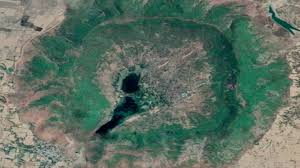Rajasthan Switch to Hindi
Rajasthan Recognizes Ramgarh Crater as India's 1st Geo-Heritage Site
Why in News?
Recently, the Rajasthan government officially recognised the 3-km diameter Ramgarh Crater at Baran district formed 165 million years ago due to a meteor impact, as the country's first Geo-Heritage Site.
Key Points
- Ramgarh Crater is significant for its ecosystem services, biodiversity, cultural, and heritage value for the local communities and society.
- This significance is reflected by its status as a declared Conservation Reserve, namely Ramgarh Conservation Reserve, under the Wildlife (Protection) Act, 1972.
- According to the State Wetland Authority, Pushkar Talab located inside the crater is a source of both saline and alkaline water, adding to the beauty and diversity of the area.
- These lakes have been notified as wetlands under the Wetland (Conservation & Management) Rules, 2017.
- Ramgarh Crater exhibits an important interchange of human values within a cultural area, reflected in developments in architecture or technology, monumental arts, town-planning,or landscape design.
- Bhand Deva Temple, influenced by Chandela dynasty and their temples at Khajuraho, is an example of such interchange.
- Its construction on a meteor impact crater adds to its uniqueness and significance.
Ramgarh Crater
- It is a meteor impact crater of 3.5 kilometres diameter in Kota plateau of Vindhya range located adjacent to Ramgarh village in Baran district in Rajasthan.
- It is formally accepted as the third crater in India, its diameter size would be between the two already confirmed craters in India - Dhala in Madhya Pradesh with 14 km diameter and Lonar in Buldhana district of Maharashtra with 1.8 km diameter.
Wildlife (Protection) Act, 1972
- It provides a legal framework for the protection of various species of wild animals and plants, management of their habitats, regulation, and control of trade in wild animals, plants, and products made from them.
- The act also lists schedules of plants and animals that are afforded varying degrees of protection and monitoring by the government.
- India's entry to the CITES (Convention on International Trade in Endangered Species of Wild Fauna and Flora) was made easier by the Wildlife Act.
- Earlier, Jammu and Kashmir was not covered by the Wildlife Protection Act of 1972. The Indian Wildlife Protection Act now applies to J&K as a result of the reorganisation act.


.png)




.jpg)























.png)


.jpg)

 PCS Parikshan
PCS Parikshan


